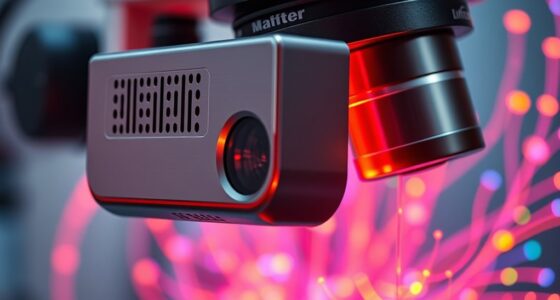If you’re looking for the 13 best liquid chromatography systems for precision and reliability in 2025, I recommend focusing on high-quality equipment like borosilicate glass columns, HPLC-grade water, and inert PTFE components that guarantee accurate results. Educational kits, portable UV analyzers, and advanced LC columns also play key roles in ensuring performance across research, industry, and teaching. Keep exploring further, and you’ll discover detailed options tailored to your specific needs.
Key Takeaways
- Top chromatography systems in 2025 emphasize high precision, durability, and compatibility with advanced analytical techniques.
- Leading systems feature high-quality components, including inert materials and customizable configurations for diverse applications.
- Industry-relevant options include models supporting pharmaceutical, herbal, and environmental sample analysis.
- Educational kits and simpler systems are integrated to support remote learning and STEM education.
- Reliability is ensured through robust construction, high-purity reagents, and comprehensive quality assurance features.
Stonylab Chromatography Column, Borosilicate Glass 300mm

If you’re looking for a reliable chromatography column that offers durability and precision, the Stonylab Borosilicate Glass Column is an excellent choice. Measuring 300mm in length with a 50mm outer diameter, it features a standard 24/40 taper top outer joint, ensuring compatibility. The column includes a fritted disc and a PTFE stopcock for smooth operation. Made from high-quality borosilicate glass, it’s handcrafted to deliver exceptional performance with a G3 15–40 μm pore size. Plus, it comes with a warranty and excellent customer support, giving you confidence in its long-term reliability and precision.
Best For: researchers and laboratory professionals seeking durable, precise chromatography columns for high-quality separation and analysis.
Pros:
- Crafted from durable borosilicate glass for longevity and resistance to thermal shock
- Includes a fritted disc and PTFE stopcock for smooth and efficient operation
- Handcrafted with a G3 15–40 μm pore size for optimal separation performance
Cons:
- May require careful handling due to glass construction to prevent breakage
- Limited to 300mm length, which might not suit larger-scale applications
- Compatibility limited to standard 24/40 taper joints, reducing versatility with other fittings
Water, HPLC Grade ACS Reagent Grade, Suitable for Liquid Chromatography
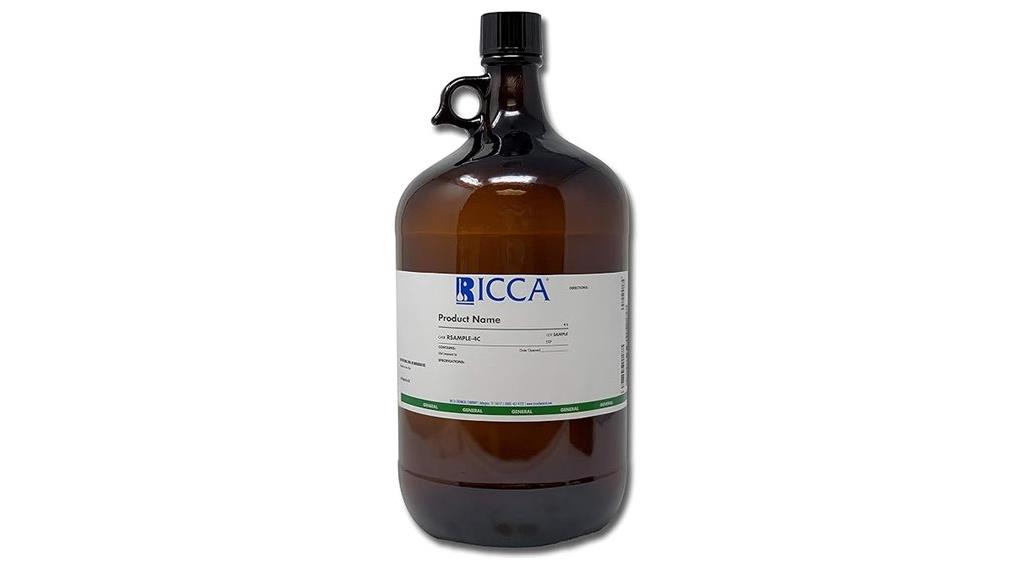
For laboratories requiring highly purified water for sensitive analytical techniques, HPLC Grade ACS Reagent Grade water is an excellent choice. Ricca Chemical’s 9153-1 offers 4 liters of water that’s suitable for liquid chromatography and ultraviolet spectrophotometry. Manufactured through a validated continuous process, it guarantees high purity and consistent quality, with lot numbers and expiration dates for traceability. Its neutral pH of around 7.824 ensures compatibility with precise measurements. This water supports accurate analytical results, making it ideal for HPLC applications and other demanding laboratory procedures. Overall, it provides the purity and reliability needed for superior performance in advanced analytical workflows.
Best For: laboratories and researchers requiring high-purity water for sensitive analytical techniques such as HPLC and ultraviolet spectrophotometry.
Pros:
- Ensures high purity suitable for precise analytical procedures.
- Manufactured through a validated continuous process for consistent quality.
- Comes with lot numbers and expiration dates for traceability and quality assurance.
Cons:
- Limited to 4-liter quantities per package, which may require multiple purchases for large-volume needs.
- Slight variations in pH (around 7.824) could affect highly sensitive measurements if not monitored.
- Not suitable for applications requiring ultrapure or deionized water beyond HPLC and reagent-grade standards.
Multiple Distributor for Bottles GL45 Insert Made of PTFE
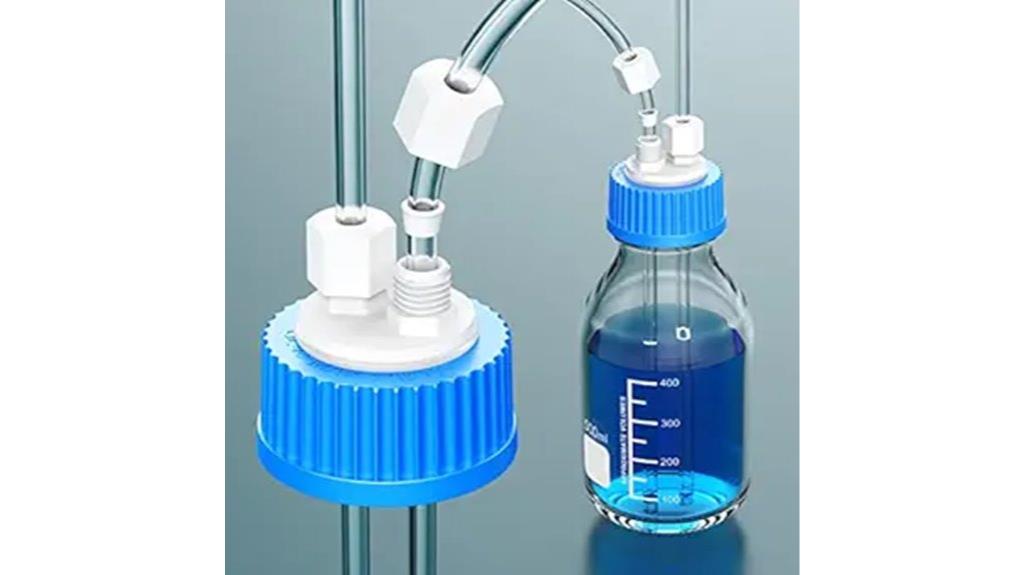
The Multiple Distributor for Bottles GL45 Insert Made of PTFE stands out as an essential component for laboratories requiring a versatile, chemical-resistant cap system. Its design fits glass media bottles with GL45 necks and includes plugs and fittings for 1/4 OD tubing, making it adaptable for various applications like HPLC, gas washing, drying, vacuum trapping, and water electrolysis. Constructed from inert PTFE with a durable polypropylene collar, it ensures chemical compatibility and reliable performance. The cap’s multiple ports and flexible configuration prevent leaks and enhance safety, even with corrosive substances or hydrogen gas. Overall, it offers a robust, corrosion-resistant solution for diverse laboratory needs.
Best For: laboratories and industrial facilities needing a versatile, chemically inert, and leak-proof cap system for GL45 bottles used in HPLC, gas handling, and chemical processing.
Pros:
- Made from inert PTFE, ensuring excellent chemical compatibility and resistance to corrosive substances.
- Multiple ports and adaptable design allow for flexible configurations and applications.
- Durable polypropylene collar provides added strength and prevents wetted components from degrading over time.
Cons:
- Slightly loose tubing holes may require additional sealing for certain applications.
- No bottle included; only the cap and fittings are provided, requiring separate bottle acquisition.
- Some users may find the multi-port setup more complex to install or adjust compared to simpler caps.
Chromatography Solvent (9:1), 500 mL – The Curated Chemical Collection
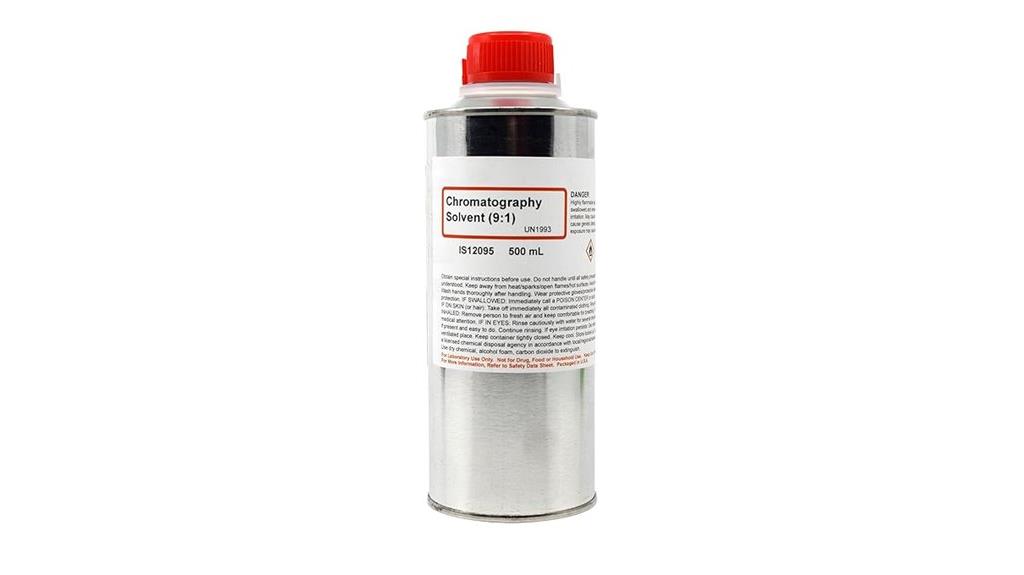
Designed specifically for educational and general-purpose laboratory use, the Chromatography Solvent (9:1), 500 mL from The Curated Chemical Collection offers reliable performance in paper chromatography applications. This high-quality solvent, made in the USA, is ideal for separating pigments from plant materials like spinach leaves, as well as analyzing inks. Its consistent results help students and researchers accurately determine Rf values, making it perfect for biology, chemistry, and forensic labs. The 36-month shelf life and reusability add value, while safety instructions guarantee proper handling. Overall, it’s a dependable choice for achieving clear, reproducible chromatography results in educational settings.
Best For: educators, students, and researchers conducting paper chromatography in biology, chemistry, or forensic labs seeking reliable, high-quality solvents for pigment and ink separation.
Pros:
- Produces clear, reproducible separation of pigments and inks for accurate Rf calculations
- Reusable solvent with a 36-month shelf life, offering cost savings and environmental benefits
- Made in the USA with high standards, ensuring consistent quality and performance
Cons:
- Not suitable for human consumption, household, or food-related applications
- Requires careful handling and storage according to safety instructions to prevent accidents
- Limited to laboratory and educational use only, restricting broader commercial or industrial applications
ALDON Paper Chromatography Science Kit

If you’re looking to introduce students to the fundamentals of chromatography remotely, the Aldon Paper Chromatography Science Kit stands out as an excellent choice. It offers a hands-on experience with simple yet effective materials, including dyes, ethanol, and chromatography sheets, to demonstrate separation techniques. The kit helps students understand how different substances move at varying rates and why separation occurs. Designed for remote learning, it comes with clear instructions, worksheets, and enough supplies for two students or groups. This engaging setup fosters active exploration of chemical behaviors, making it ideal for building foundational knowledge of chromatography in a remote educational environment.
Best For: educators and students seeking an interactive, hands-on introduction to chromatography in a remote learning setting.
Pros:
- Provides a comprehensive, all-in-one kit with essential materials for practical experimentation.
- Facilitates active learning and understanding of chemical separation processes remotely.
- Includes clear instructions and worksheets to support independent student exploration.
Cons:
- Limited to basic dyes and may not cover more advanced chromatography techniques.
- Requires access to ethanol, which may need careful handling and supervision.
- Suitable primarily for small group or individual learning environments, not large classroom settings.
Herb Pharm Andrographis Liquid Extract (DANDRO01)

Liquid Chromatography Systems are ideal for accurately analyzing complex herbal extracts like Herb Pharm Andrographis Liquid Extract, especially when high precision and detailed profile data are required. I rely on these systems to guarantee the extract’s potency and purity, verified through techniques like High Performance Thin Layer Chromatography (HPTLC). This allows me to detect active compounds and confirm quality consistency. With the intricate composition of this herbal extract—containing certified organic plant material, alcohol, and water—precise chromatography helps in maintaining product standards. Ultimately, advanced LC systems provide the confidence needed when evaluating herbal products for safety, efficacy, and compliance.
Best For: individuals seeking a natural, organic liquid supplement to support immune health, especially during illness, cold seasons, or for immune response enhancement.
Pros:
- Supports immune health and may shorten cold duration
- Made from certified organic or sustainably wildcrafted Andrographis paniculata
- Rapidly absorbed liquid form with high potency verified through advanced chromatography
Cons:
- Has a very bitter, challenging taste that some may find unpleasant
- Not suitable for pregnant women or those trying to conceive
- Difficult to find in physical stores, primarily available online
Innovating Science Paper Chromatography Kit to Separate Chemical Substances

The Innovating Science Paper Chromatography Kit is an excellent choice for middle and high school students enthusiastic to explore chromatography firsthand. It helps students understand how chemical substances separate based on their affinity for solvents and paper. The kit includes materials to analyze dyes and their mixtures, supporting up to 15 student groups under adult supervision. It complies with safety standards, including DOT exemptions, ensuring safe transport and handling. With hands-on activities that integrate math and science principles, this kit makes complex concepts accessible and engaging, fostering inquiry and practical understanding of chromatography’s role in chemistry, biology, and environmental sciences.
Best For: middle and high school students and educators seeking an engaging, hands-on introduction to chromatography and chemical separation concepts.
Pros:
- Supports up to 15 student groups, facilitating collaborative learning
- Meets safety and transportation standards, ensuring secure handling and shipping
- Combines practical experiments with STEM education, reinforcing core science principles
Cons:
- Designed for ages 13+; may not be suitable for younger students without adaptation
- Limited to dye analysis; may require supplementary activities for broader chemistry exploration
- Requires adult supervision, which could limit independent student experimentation
Porous Plastic Liquid Chromatography SPE Column Frits (1,000 Pack)

Designed for laboratories and industrial settings demanding reliable filtration, the Porous Plastic Liquid Chromatography SPE Column Frits in a 1,000-pack offer a cost-effective solution for consistent media retention. Made from UHMW polyethylene copolymer, these frits feature a 30-micron pore size suitable for filtering various liquids in chemical analysis. They come in hydrophobic and hydrophilic formulations, ensuring versatility for different testing needs. With standard dimensions of .090 inches thick and .354 inches in diameter, they provide durable, precise filtration. Sold in large packs, they support high-volume testing, making them ideal for ensuring consistent, reliable filtration in demanding analytical environments.
Best For: laboratories and industrial facilities seeking reliable, high-volume filtration solutions for chemical analysis and liquid testing.
Pros:
- Cost-effective for large-scale testing with 1,000-unit packs
- Made from durable UHMW polyethylene copolymer with precise dimensions
- Suitable for both hydrophobic and hydrophilic applications
Cons:
- Pore size of 30 microns may not be suitable for ultra-fine filtration needs
- Standard tolerances may require careful handling for tight-fitting applications
- Limited to specific sizes and formulations, reducing customization options
Liquid Chromatography Column 00F-4252-C0 C18 3.9 * 150mm 5um Original

If you’re seeking high-resolution separation for complex samples, the Liquid Chromatography Column 00F-4252-C0 C18 3.9*150mm 5μm Original is an excellent choice. Designed for precision, it supports diverse applications like pharmaceuticals and analytical testing. Its robust construction guarantees consistent, reproducible results over long-term use, making it reliable for demanding environments. The column offers multiple separation modes, including reversed-phase and affinity chromatography, providing flexibility for various analytical needs. With its high flow rate durability and rapid separation capabilities, I find it ideal for high-throughput analysis where accuracy and dependability are essential.
Best For: researchers and technicians needing high-resolution, reliable separation in pharmaceutical, analytical, and complex sample analysis.
Pros:
- Supports multiple separation modes including reversed-phase and affinity chromatography for versatile applications
- Manufactured for long-term use with consistent, reproducible results
- Capable of high throughput and rapid separations, ideal for demanding analytical environments
Cons:
- May require specialized equipment and training to optimize performance
- Higher cost due to its high-quality construction and materials
- Limited to specific sample types; may not be suitable for all chromatography needs
Liquid Chromatography Column 075718 C30 250 * 4.6mm 5um Original

This liquid chromatography column is ideal for researchers and analysts who require high-resolution separation of complex samples. The 075718 C30 250 * 4.6mm 5um original offers excellent performance across pharmaceutical and analytical applications. It’s designed for consistent, reproducible results, ensuring reliability over long-term use. Built to handle high flow rates, it supports rapid, high-throughput analyses. Its versatile separation modes—including reversed-phase, normal-phase, and affinity chromatography—make it adaptable to various tasks. The optimized design and durable materials guarantee durable, high-quality separations, making it a dependable choice for demanding analytical environments.
Best For: researchers and analysts needing high-resolution, reliable separation of complex samples in pharmaceutical and analytical applications.
Pros:
- Provides high-resolution separation for complex sample analysis
- Ensures repeatability and reproducibility over long-term use
- Supports rapid, high-throughput analyses with high flow rate capacity
Cons:
- May require specialized training for optimal use
- Potentially higher cost compared to less advanced columns
- Limited to applications compatible with its separation modes and specifications
Stonylab Portable UV Analyzer for Laboratory UV Light Intensity Testing
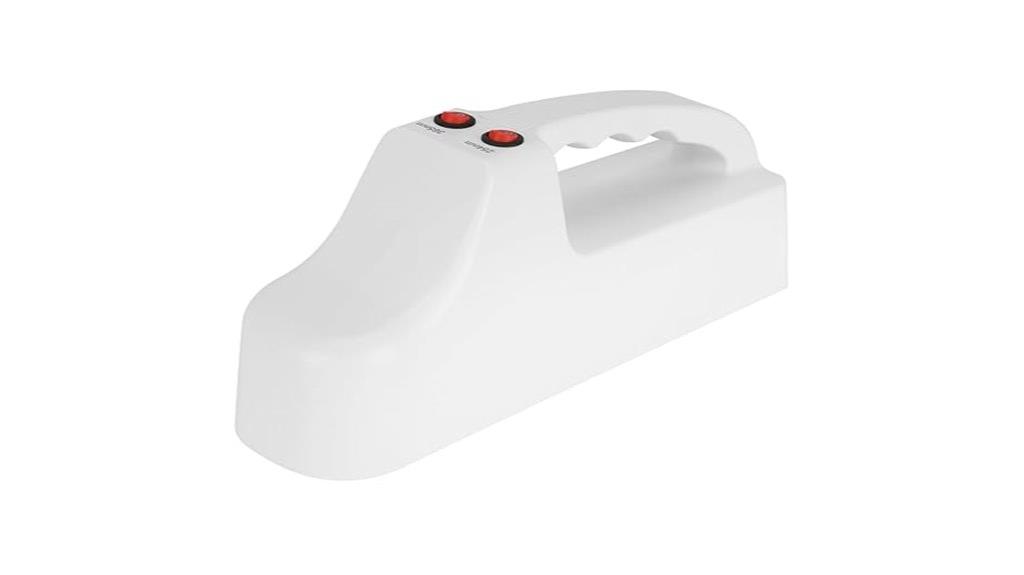
The Stonylab Portable UV Analyzer stands out for its durable metal housing, making it ideal for laboratories that require reliable, on-the-go UV light intensity testing. Its robust construction guarantees it can withstand daily use and transport, providing consistent performance. Equipped with a high-quality quartz glass UV lamp and adjustable sources at 254nm and 365nm, it delivers stable, precise illumination essential for thin-layer chromatography and fluorescent dye testing. Its design supports continuous operation, ensuring dependable results. Plus, the white housing enhances visibility during testing. If you encounter any damage, customer support is quick to assist, ensuring your testing process remains uninterrupted.
Best For: laboratory professionals and researchers needing durable, portable UV light testing equipment for precise analysis in thin-layer chromatography and fluorescent dye testing.
Pros:
- Robust metal housing ensures durability and longevity in demanding environments
- Equipped with adjustable UV sources at 254nm and 365nm for versatile testing needs
- Supports continuous operation for reliable, consistent results
Cons:
- May be more expensive than basic UV testing devices
- Requires proper handling to maintain the integrity of the quartz glass UV lamp
- Not designed for use outside laboratory settings or heavy-duty industrial environments
Herb Pharm Organic Eyebright Liquid Extract

Liquid Chromatography Systems excel at analyzing herbal extracts like Herb Pharm Organic Eyebright Liquid Extract, especially when evaluating quality and consistency. These systems help verify the extract’s potency, which is confirmed through High Performance Thin Layer Chromatography (HPTLC) analysis. Since the extract is made from sustainably wildcrafted, fresh Euphrasia officinalis plants, precise testing guarantees the active compounds meet quality standards. With its rapid absorption and high potency, this extract benefits from LC systems that can detect subtle variations. Overall, using advanced chromatography ensures consumers receive a safe, effective product, maintaining transparency and trust in herbal supplement quality.
Best For: individuals seeking a natural, effective remedy for respiratory support and allergy relief, especially during hay fever season.
Pros:
- Made from sustainably wildcrafted, fresh Euphrasia officinalis plants, ensuring high quality and potency
- Rapid absorption and strong efficacy in alleviating allergy symptoms such as sneezing, itchy eyes, and runny nose
- Verified potency through High Performance Thin Layer Chromatography (HPTLC), maintaining transparency and quality standards
Cons:
- Contains approximately 25% alcohol, which may not be suitable for everyone and is not always clearly indicated online
- Strong taste may require mixing with juice or water, and some users experience stinging when mixed with certain cups
- Price may be higher than synthetic alternatives, and availability can vary across platforms
Liquid Chromatography Column 1.50470.0001 RP-18,150 * 4.6 3um

If you’re working with pharmaceutical, analytical, or complex sample analysis, the Liquid Chromatography Column 1.50470.0001 RP-18 is an excellent choice because it offers high-resolution separation and reliable performance. Its 150 x 4.6 mm size with a 3 µm particle provides sharp, consistent peaks, ideal for detailed analysis. Designed to withstand high flow rates, it supports rapid, high-throughput separations. The manufacturing process ensures exceptional repeatability and long-term stability, guaranteeing dependable results over time. Versatile in application, it supports various separation modes, making it a valuable tool for complex sample analysis and diverse analytical tasks.
Best For: researchers and analysts involved in pharmaceutical, analytical, and complex sample analysis seeking high-resolution, reliable separation performance.
Pros:
- Provides high-resolution separation for diverse analytical needs.
- Supports high throughput and rapid separations due to withstand high flow rates.
- Ensures excellent repeatability and long-term stability for dependable results.
Cons:
- May be more expensive than lower-grade columns.
- Requires precise handling and maintenance to preserve performance.
- Limited to specific sample types; less effective for samples outside its designed separation modes.
Factors to Consider When Choosing Liquid Chromatography Systems

When selecting a liquid chromatography system, I focus on how well it matches my sample types and detection needs. I also consider its throughput capacity and how easy it is to operate and maintain. These factors guarantee I choose a system that’s efficient, reliable, and suited to my specific workflow.
Compatibility With Samples
Choosing the right liquid chromatography system hinges on guaranteeing its compatibility with your samples’ chemical properties. I look at the stationary phase to match the polarity and molecular weight of my samples, securing optimal separation. I also verify that the system supports the solvent and pH ranges needed for sample prep and analysis. Sample volume capacity and injection methods must align with my sample size and format to prevent loss or overload. Additionally, I check that the detection techniques—like UV, fluorescence, or mass spectrometry—fit my analytical goals. Finally, I guarantee the system’s materials are chemically inert and resistant to any corrosive or reactive constituents in my samples, preventing degradation or contamination. Compatibility is key to reliable, accurate results.
Detection Method Options
Selecting the appropriate detection method is vital to obtaining accurate and meaningful results from your liquid chromatography system. Different detection options, like UV-Vis, fluorescence, mass spectrometry, and refractive index, vary in sensitivity and selectivity. UV-Vis detection is popular due to its simplicity and ability to monitor compounds absorbing UV or visible light, with detection limits in the nanogram range. Mass spectrometry offers high sensitivity and detailed structural information, ideal for complex mixtures and trace analysis. Fluorescence detection provides exceptional sensitivity for fluorescent compounds, often reaching picogram detection limits, but requires analytes to fluoresce naturally or after derivatization. Refractive index detectors are universal but less sensitive, suited for non-UV absorbing compounds with higher detection thresholds. Choosing the right method depends on your analytes and desired sensitivity.
System Throughput Capacity
Have you ever considered how the capacity of your liquid chromatography system impacts your laboratory’s efficiency? Higher throughput means you can analyze more samples in less time, boosting productivity. The flow rate and pressure limits are key; they determine how quickly large sample volumes can be processed without compromising performance. Automated sample injection and rapid column switching further enhance throughput by reducing manual handling and speeding up analysis. Additionally, the choice of column dimensions, like length and internal diameter, influences separation speed and overall capacity. Advanced system features such as multiplexing capabilities and high-pressure operation enable simultaneous processing of multiple samples. When selecting a system, prioritizing these throughput factors guarantees your lab stays efficient, meets deadlines, and maximizes sample analysis without sacrificing data quality.
Ease of Operation
When evaluating liquid chromatography systems, ease of operation plays a crucial role in streamlining laboratory workflows. An intuitive interface with clear displays and straightforward setup reduces user errors and speeds up training. Systems with automated sample injection and method development further simplify processes, allowing operators to focus on analysis rather than manual adjustments. User-friendly features like touchscreens and pre-programmed methods enable quick learning and efficient operation, even for less experienced users. Clear labeling of ports, quick-connect fittings, and simple maintenance procedures minimize hassle and downtime. Compatibility with existing workflows and minimal calibration needs contribute to smooth, reliable operation. Overall, choosing a system that’s easy to operate ensures faster results, increased productivity, and fewer operational frustrations.
Maintenance Requirements
Maintenance requirements are a critical factor to take into account when choosing a liquid chromatography system, as proper upkeep ensures consistent performance and long-term reliability. Regular cleaning or replacement of column frits prevents clogging and maintains ideal flow rates. Routine calibration and validation of detectors and pumps are essential for accurate, reproducible results. Inspecting and replacing tubing, seals, and filters help prevent leaks and contamination. Keeping mobile phase reservoirs and waste containers clean and properly disposed of avoids cross-contamination and reduces system downtime. Scheduled servicing, including leak checks and pressure verification, extends the lifespan of the system and guarantees stable operation. Prioritizing these maintenance tasks helps maintain peak performance and reduces unexpected breakdowns, making maintenance a key consideration when selecting your chromatography system.
Cost and Budget
Choosing a liquid chromatography system requires careful consideration of both upfront costs and ongoing expenses. The initial investment can vary widely, from a few thousand to over fifty thousand dollars, based on features and capabilities. Beyond purchase price, operating costs—such as consumables like columns, solvents, and routine maintenance—significantly impact the total budget over time. Budget constraints often influence whether I opt for high-end systems with advanced automation or more basic models for routine analyses. It’s also essential to factor in costs for training, support, and potential upgrades, which add to overall expenses. To manage costs effectively, I look for scalable or modular systems that can expand or upgrade as needed, ensuring long-term value without overspending upfront.
Instrument Durability
The durability of liquid chromatography systems hinges on the quality of their components, such as columns, frits, and housings, which must resist chemical corrosion and physical stress. Using high-grade materials like borosilicate glass, stainless steel, or inert plastics ensures these parts withstand aggressive solvents and high pressures, prolonging their lifespan. The design of seals, stopcocks, and fittings also plays a critical role in resisting leaks and mechanical failure over repeated use. Proper maintenance and regular cleaning are essential to prevent wear and damage, further extending system durability. When selecting a system, I recommend choosing models with proven reliability, reinforced columns, and corrosion-resistant fittings. These features help minimize downtime and reduce replacement costs, ensuring long-term operational stability.
Frequently Asked Questions
How Do System Throughput and Sample Capacity Affect Choice?
System throughput and sample capacity are vital factors I consider when choosing a liquid chromatography system. Higher throughput allows me to process more samples quickly, boosting efficiency. Greater sample capacity means I can run larger batches without frequent reloads, saving time. Balancing these features ensures I select a system that meets my lab’s demand for speed and capacity, ultimately improving my workflow and productivity.
What Maintenance Routines Ensure Long-Term System Reliability?
I keep my chromatography system dependable by performing regular maintenance routines like checking and replacing filters, cleaning the injection port, and calibrating detectors. I also verify solvent deliveries and inspect tubing for wear and tear. Consistent system flushing and updating software help prevent issues. Staying proactive with these routines ensures my system runs smoothly, maintains accuracy, and provides long-term reliability, saving me time and costly repairs down the line.
How Does Software Integration Impact Data Accuracy?
Software integration greatly impacts data accuracy because it streamlines data collection, minimizes manual entry errors, and guarantees consistent processing. When systems are well-integrated, I can trust that the data flows seamlessly from the instrument to analysis software, reducing discrepancies. It also allows for real-time monitoring and automatic validation, which boosts confidence in the results. Overall, good software integration is key to achieving precise, reliable, and reproducible data.
What Are the Environmental Considerations for Operation?
Environmental considerations for operation are like tending a garden—you need to nurture it carefully. I guarantee proper waste disposal, minimize solvent use, and opt for energy-efficient systems. Regular maintenance reduces waste and energy consumption, helping protect our planet. By choosing eco-friendly practices, I not only improve lab sustainability but also ensure my chromatography system runs reliably, reflecting my commitment to environmentally responsible science.
How Do Different Detector Types Influence Analysis Sensitivity?
Different detector types markedly influence analysis sensitivity in liquid chromatography. For example, UV detectors are versatile and sensitive for many compounds, but fluorescence detectors offer higher sensitivity for specific analytes. Mass spectrometers provide the greatest sensitivity and specificity, ideal for trace analysis. Your choice depends on your target compounds and required detection limits, but understanding each detector’s strengths helps optimize your system’s sensitivity and overall performance.
Conclusion
Choosing the right liquid chromatography system is like finding the perfect compass for your scientific journey—it guides you with precision and reliability. With so many options in 2025, I encourage you to consider your specific needs carefully. When you select wisely, you’ll navigate the complex world of analysis smoothly, opening discoveries that shine as brightly as a lighthouse guiding ships through the night. Your lab’s success depends on the tools you trust—choose them wisely.





